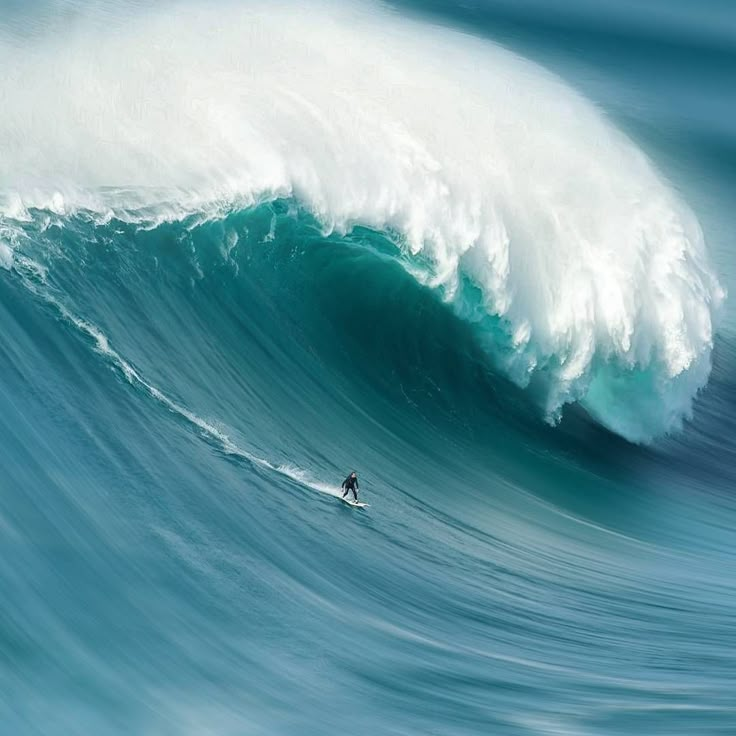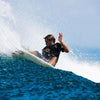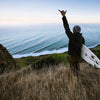9 of the biggest waves in the world

9 of the biggest waves in the world
The tallest wave ever recorded reached 1,720 feet in Lituya Bay, Alaska, after a 1958 earthquake triggered a massive landslide. It was not surfed but remains the highest wave in human history.
In the surf world, the biggest waves ever ridden include an 86-foot wave by Sebastian Steudtner at Nazaré, an 80-footer by Rodrigo Koxa, and a 77-foot wave by Mike Parsons at Cortes Bank. The 100-foot wave remains the ultimate challenge.
Here are nine of the biggest and most iconic waves on the planet, known for their size, power and danger.
What are the biggest waves in recorded history?
The biggest wave ever measured occurred on July 9, 1958, in Lituya Bay, southeast Alaska. A 7.8-magnitude earthquake caused a rockslide that sent millions of tons of earth crashing into the bay, displacing water with explosive force.
The result was a megatsunami that surged 1,720 feet up the mountainside, flattening everything in its path. Three fishing boats were in the bay at the time. Two managed to ride the surge and survived. One was destroyed, and two people died.
Although not surfable, the Lituya Bay event is considered the most powerful single wave ever documented.
In terms of surfed waves, the largest verified rides are:
-
86 feet at Nazaré, Portugal (Sebastian Steudtner, 2020)
-
80 feet at Nazaré, Portugal (Rodrigo Koxa, 2017)
-
77 feet at Cortes Bank, California (Mike Parsons, 2008)
Each of these waves pushed the limits of big wave surfing and brought the goal of riding a 100-foot wave closer to reality.
1- Nazaré, Portugal
Nazaré has become the global capital of big wave surfing. Located on Portugal’s Atlantic coast, this former fishing village is now known for producing the biggest surfable waves on Earth.
The key to Nazaré’s massive swells lies beneath the surface. Just offshore is the Nazaré Canyon, an underwater trench that plunges to around 5,000 meters deep. This geological feature funnels and amplifies ocean swells, allowing waves to rise dramatically as they reach the shallow coastal shelf near Praia do Norte.
In recent years, Nazaré has been the site of several world-record rides:
-
In 2011, Garrett McNamara surfed a 78-foot wave, putting Nazaré on the map
-
In 2017, Rodrigo Koxa surfed an 80-foot wave, verified as the largest ever ridden at the time
-
In 2020, Sebastian Steudtner rode an 86-foot wave, confirmed by Guinness World Records in 2022
The waves at Nazaré break close to shore, making it a unique place where spectators can safely watch surfers take on these massive walls of water. The lighthouse at the Fort of São Miguel Arcanjo offers a prime viewing point and has become an iconic backdrop for some of the most dramatic surf photography in the world.
For anyone curious about similar ocean patterns that create dangerous conditions, the phenomenon of square waves is worth knowing about.
2- Peahi (Jaws), Maui
Peahi, better known as Jaws, is Hawaii’s most powerful big wave and one of the most respected surf breaks in the world. Located on the north shore of Maui, Jaws is known for producing fast, steep, and heavy waves that can reach heights of 70 to 80 feet during peak winter swells.
What makes Jaws especially dangerous is how quickly the wave builds and breaks. The deep ocean swells rise suddenly over a shallow reef, creating thick, hollow walls of water with massive power. The speed and intensity of the wave often make it too fast to paddle into, which is why Jaws became the birthplace of tow-in surfing.
In the 1990s, surfers like Laird Hamilton and Buzzy Kerbox began using jet skis to tow themselves into waves too big and fast to catch by paddling. This innovation changed the sport and opened the door to a new era of big wave riding.
In January 2023, Jaws delivered one of its biggest swells in recent memory, with wave faces estimated between 70 and 80 feet. Despite the risks, it remains a proving ground for elite surfers looking to test themselves against one of the most technically demanding waves in the world.
If you’re just starting to explore the world of surf culture, understanding basic surfing terms can help you appreciate the skill it takes to ride waves like these.
3- Cortes Bank, California
Cortes Bank is one of the most remote and mysterious big wave locations on Earth. Situated about 100 miles off the coast of Southern California, it is an underwater seamount that rises from deep ocean depths to just a few feet below the surface at its shallowest point, known as Bishop Rock.
When the conditions align — a long-period swell, light winds, and a low tide the reef at Cortes Bank transforms into a massive wave machine. The open-ocean setting and absence of nearby land allow for clean, unimpeded wave formation. On the right day, waves at Cortes Bank can reach 60 to 80 feet and beyond.
Surfing here is not easy. The location is only accessible by boat, and the swell window is narrow and difficult to predict. The combination of powerful waves and complete isolation means that any mistake can have serious consequences.
In 2008, Mike Parsons surfed a 77-foot wave here, setting a world record at the time. Four years later, Shawn Dollar paddled into a 61-foot wave, the largest ever paddled into at that point.
Cortes Bank is not surfed often, but it remains legendary for those who seek waves in their rawest form.
4- Mavericks, California
Mavericks is one of the most iconic and dangerous big wave surf spots in the world. Located just outside Half Moon Bay in Northern California, this cold-water break is known for its unpredictable conditions, sharp reefs, and waves that can reach heights of 60 feet or more during the winter swell season.
Discovered by local surfer Jeff Clark in the 1970s, Mavericks remained a secret for years before gaining recognition in the 1990s. The wave breaks over a shallow reef that juts out into the Pacific, focusing incoming swell energy into massive, hollow peaks.
In December 2024, 23-year-old surfer Alessandro “Alo” Slebir reportedly rode a wave estimated at 108 feet. If confirmed, it would surpass the current world record held at Nazaré. The ride is still under review but has already drawn significant attention in the surf world.
Mavericks is also famous for its annual invitational contest, held only when the right conditions occur. Successfully riding a wave at Mavericks is considered a major milestone for any big wave surfer.
5- Teahupo’o, Tahiti
Teahupo’o, located on the southwest coast of Tahiti, is known as one of the heaviest and most dangerous waves in the world. The wave breaks over a shallow coral reef, creating a fast, hollow barrel with a lip that can be as thick as the wave is tall.
The reef lies just below the surface, leaving little room for error. A wipeout here can mean serious injury. Despite the risks, Teahupo’o remains a favorite among elite surfers looking to test their limits.
During the 2024 Paris Olympics, Teahupo’o hosted the surfing competition. Waves reached around 10 feet, but the break has seen far larger. In August 2023, Australian surfer Laurie Towner paddled into a wave estimated at over 25 feet.
Teahupo’o is also the site of the Billabong Pro Tahiti, one of the most anticipated events on the World Surf League tour.
6- Waimea, Hawaii
Waimea Bay, on the north shore of Oahu, holds a special place in the history of big wave surfing. It was one of the first places in the world where surfers deliberately sought out massive waves.
Waves at Waimea can reach heights of 30 feet or more during the winter months. The bay is deep and open to long-period North Pacific swells, which roll in and explode onto the reef close to shore.
Waimea is best known for hosting The Eddie, a prestigious big wave event held only when wave heights reach a minimum of 20 feet Hawaiian scale (around 40 feet face height). In January 2025, The Eddie was held again, with local surfer Landon McNamara taking the win.
Beyond its surf, Waimea Bay is part of Hawaiian cultural history and a symbol of courage and respect for the ocean.
7- Donegal Bay, Ireland
Donegal Bay, on Ireland’s northwest coast, is home to Mullaghmore Head, one of Europe’s most powerful big wave breaks. It awakens during major winter swells from the North Atlantic, sending waves up to 50 feet crashing over the reef.
Mullaghmore is known for its thick barrels, cold water, and rocky shoreline. The wave breaks close to cliffs, and access can be difficult, making it one of the more dangerous places to surf in Europe.
In November 2023, waves reached 40 feet at Mullaghmore. Local surfer Conor Maguire, one of Ireland’s top big wave athletes, made headlines with several successful rides.
Donegal Bay may not have the fame of Nazaré or Jaws, but it is held in equal regard by those who ride it.
8- Shipstern Bluff, Tasmania
Shipstern Bluff, located in southern Tasmania, is one of the most unique big waves in the world. Its signature feature is the presence of multiple steps or ledges within the wave face, which cause sudden drops and add a new level of difficulty to each ride.
The wave is thick, fast, and unpredictable. It breaks over a sharp reef and is only accessible by boat or a long hike through remote terrain.
Waves here can reach 20 to 30 feet, but it’s the shape and intensity that set Shipstern apart. Surfers must navigate both the wave and its inner steps, making every ride a mental and physical test.
Only a handful of surfers have truly mastered Shipstern Bluff, but it continues to attract attention as one of the world’s strangest and most dangerous waves.
9- Dungeons, South Africa
Dungeons sits just outside Cape Town in the shadow of the Sentinel mountain. It is South Africa’s most well-known big wave and one of the heaviest on the continent.
The wave can reach 50 to 60 feet and breaks over deep reef. Strong currents, cold water, and the presence of sharks add to its reputation.
Dungeons gained global fame through the Red Bull Big Wave Africa event. Although the contest is no longer held annually, the wave remains a key destination for big wave surfers.
Few waves combine raw energy, isolation, and risk the way Dungeons does. It’s a wave that demands respect from everyone who attempts it.
For surfers preparing for spots like this, having the right gear is crucial. Check out this guide to the best surf watches of 2025 to stay safe and dialed in when timing is everything.
Conclusion
Across the world, from the icy waters of Alaska to the tropical reefs of Tahiti, the ocean has produced waves that defy belief. Some, like the 1,720-foot megatsunami in Lituya Bay, are natural disasters beyond human scale. Others, like the waves at Nazaré or Cortes Bank, have become arenas for surfers chasing the outer limits of what’s physically and mentally possible.
Each of the nine waves featured in this article offers something different: height, power, danger, or technical challenge. Some break close to shore and attract crowds. Others rise in remote places, seen by only a few. But all of them share one thing: they remind us that the ocean is never fully understood, never fully tamed.
For big wave surfers, these spots are more than destinations. They are obsessions. And for the rest of us, they offer a glimpse into the raw, overwhelming force of nature — and the rare individuals willing to face it head-on.
And if you're building your surf lifestyle, knowing the surf brands every surfer should know in 2025 can help connect you with the gear, style, and community shaping the sport today.






